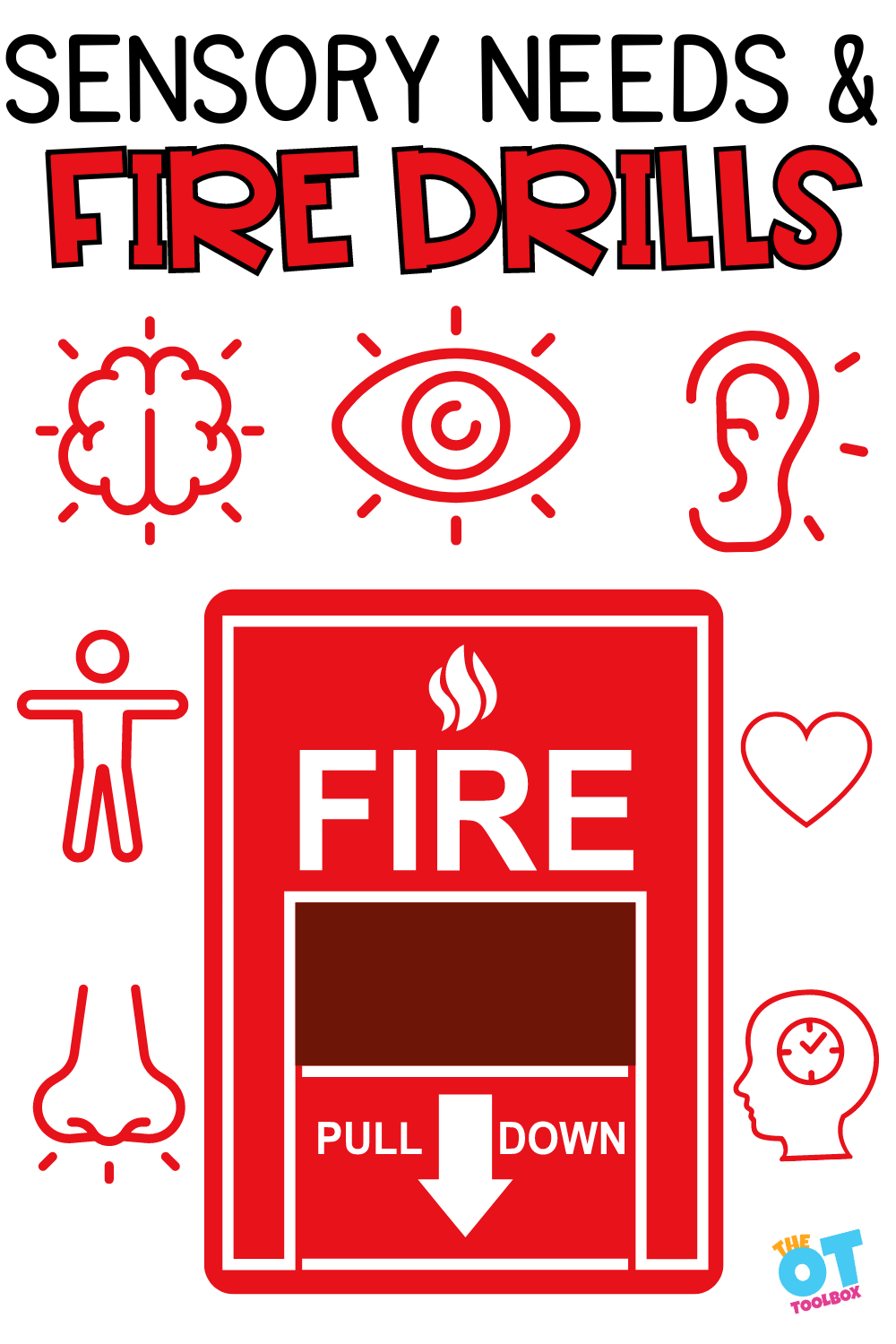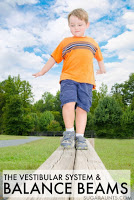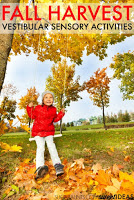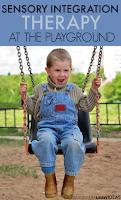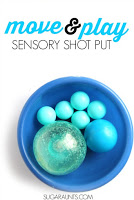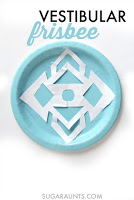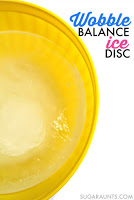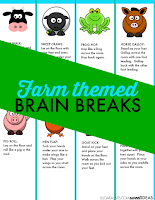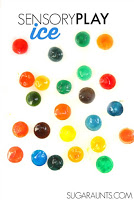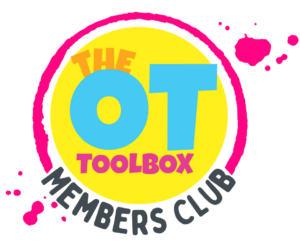As humans, we move all day long. But did you know the power of vestibular activities on daily function, learning, and occupation? Therapists use movement and play based tasks with sensory tools like obstacle courses, sensory swings, scooter boards, and slides to develop coordination and motor planning in daily activities. However, there’s more too it. Vestibular sensory input can be alerting or calming to our nervous systems, allowing us to learn, interact with others, and go through our day. Here, we’re unpacking everything you need to know about vestibular processing and the vestibular system. Let’s move!
Vestibular Activities
We’ll cover an extensive list of movement based activities that impact the vestibular system so that one can function. You’ll find alerting sensory activities for those needing more sensory input in order to function.
You’ll also find calming sensory activities for those needing to organize their systems and bodies in order to function.
These various movement-based strategies can be powerful for seeking vestibular input. They can also be a valuable tool for those avoiding movement.
These sensory vestibular activities are playful ways to promote performance and tolerance to movement activities. They are also challenges against gravity to help kids with difficulties in equilibrium, balance, self-regulation, and adjusting to typical sensory input. Read here about the development of balance for an additional resource.
Add these resources to the ones you can find here under sensory diet vestibular activities to meet the sensory needs of all kids.
Vestibular activities impact learning, social interaction, coordination, attention, and facilitation of tasks through organizing sensory input. But what exactly is “vestibular”? Let’s break it down.
Vestibular Sensory Input
Vestibular sensory input is a powerful tool in helping children with sensory needs. Adding a few vestibular activities to the day allows for long-lasting effects. Every individual requires vestibular sensory input in natural development. In fact, as infants, we are exposed to vestibular input that promotes a natural and healthy development and integration of all systems.
Movement activates the vestibular system and the vestibular system allows movement and participation in tasks. What do I mean by this statement?
Think about movements such as:
- Dance
- Spinning
- Kneeling on your knees
- Laying on a couch
- Crawling
- Standing on a ladder
- Laying on your belly to read a book
- Walking on your tiptoes
- Doing somersaults
- Navigating monkey bars
- Going up or down the stairs
- Bouncing on a trampoline
- Riding in an elevator
- Driving down a hill in a car
- Sliding on a sled
- Rocking in a rocking chair
How do each of these movements make you feel? Calm? Alert? Wired? Relaxed? Do your hands sweat just thinking about heights? Does the thought of a roller coaster make you feel queasy?
Movements impact the way we feel! Movements impact behavior!
Vestibular Input and Interoception
For some of us, we can’t tolerate heights, spinning motions, roller coasters, jumping on trampolines, or hanging your head upside down. That’s because of the way the vestibular system processes movements and integrates with our interoceptive sensory system.
These motions might make your stomach roll, your hands sweat, or the bottoms of your feet sweat? This is the interoceptive system activating.
Interoception refers to internal feelings like hunger, thirst, body temperature, and other internal processes. While the interoceptive system is impacted by a variety of internal or external inputs (room temperature impacts body temperature), the vestibular system is just one connection. Internal responses in the interoceptive system and the feelings we feel can be visceral in response to sensory input or movement.
This can be where we see sensory-avoiding or sensory-seeking responses.
This sensory processing disorder checklist can offer more information.
It will help to explore more about the vestibular system to understand this more fully.
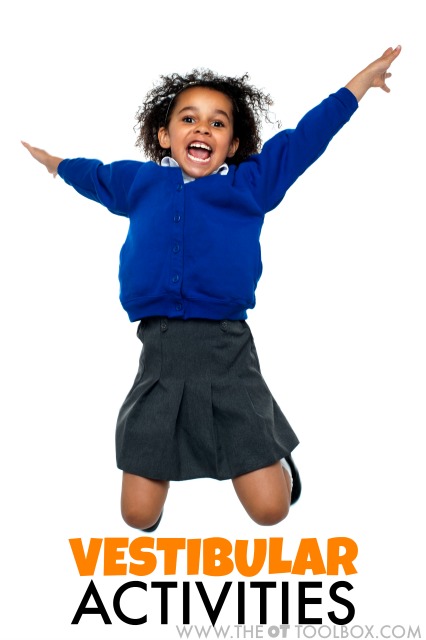
What is the vestibular system?
The vestibular system operates through receptors in the inner ear and in conjunction with position in space, input from the eyes, and feedback from muscle and joint receptors, is able to contribute to posture and appropriate response of the visual system to maintain a field of vision.
These receptors are actually hair cells that are found in two structures in the inner ear:
- Receptors on the Otolith organs respond to linear movement, gravity, and head tilt.
- Receptors on the semicircular canals respond to angular movement of the head and quick movement changes.
These receptors provide information to the central nervous system about the body’s position in space and project information to several areas:
- Cerebellum– Information received in the cerebellum is used to control posture, eye, and head movements.
- Oculomotor nuclei– Information received here help to correct the eyes with head and body movements.
- Spinal cord– Information received here helps with muscle tone and postural adjustments.
- Thalamus and cortex– Information received here helps with perception of motion and spatial orientation and integrates somatosensory information.
Types of Vestibular Movement
The vestibular sensory processing system involves several types of movements:
- Linear Movements- These movements are when the body moves in a straight line. Linear movements often occur (but not always) in a repetitive manner. It includes moving back and forth like when rocking in a rocking chair or swinging in a swing.
- Lateral Linear- Side to side movements like when shifting weight from one foot to the other.
- Up and Down Linear- Moving up and down like when jumping
- Forward and back Linear- Moving forward and then back like when swinging on a swing.
- Rotary Movements- This is when the body moves around in a circle (remember the rotary phone??). You’ll see this movement when playing games like duck duck goose, riding on a merry go round, or playing Ring Around the Rosie with friends.
- Orbital Movements- This is another version of spinning, but the child spins on an axis from the center of the body. You see this with sensory swings that are turned in a circle or on a tire swing that is spun from the center.
- Inverted Movements- Therapy providers use the therapy ball all the time for this movement. Inverted head movements are when the head is positioned below the body. Other examples are doing head stands or hand stands, cartwheels, and tumbles.

Problems with the Vestibular processing System
When there is a problem with the visual processing system, there are many features you may see.
These might be considered red flags of vestibular processing problems:
- Poor visual processing
- Poor spatial awareness
- Poor balance
- Difficulty with bilateral integration
- Sequencing deficits
- Poor visual-motor skills
- Poor constructional abilities
- Poor discrimination of body position
- Poor discrimination of movement
- Poor equilibrium
- Subtle difficulties discerning the orientation of head
- Trouble negotiating action sequences
To address these concerns, it can help to have vestibular activity plan in place.
There are benefits of vestibular input, too.
Because we are constantly moving in our daily activities, and constantly inundated by movement, changes in body position, surfaces, and positioning (consider the surface you are sitting on right now), the vestibular system is always “on”.
The vestibular system allows us to know where our body is in space, no matter the position or external input.
It allows us to move from position to position. It allows us to move the body in a coordinated manner so that we are able to participate in functional tasks.
The vestibular system enables balance, coordination, and motor planning during tasks, in familiar or unfamiliar spaces. It allows us to carry objects and facilitate occupational performance in everything we do during the day.
It allows us to be aware of the world around us, even if we are not actiley thinking of how movement impacts function.
Vestibular input can calm us down (slowly rocking or swinging) or it can alert us (quickly jumping or spinning).
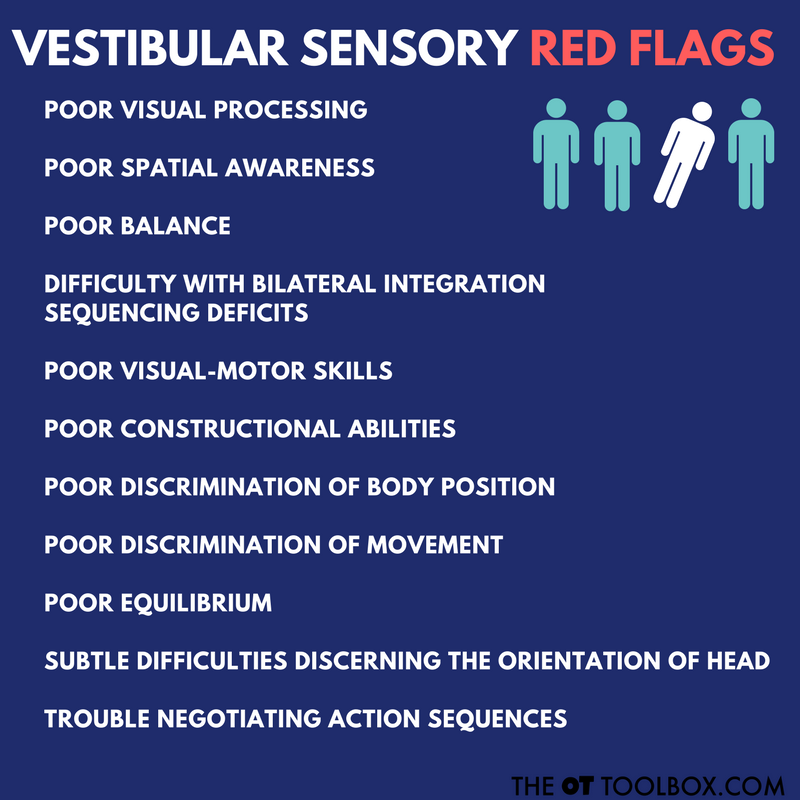
Vestibular Activity Movements
To treat and address problems with vestibular sensory processing, activities should provide movement and resistance to movement. In these activities, it is essential that children have active participation.
Depending on the individualized needs of the child, activities can be designed to include movements such as:
- Prone swinging
- Seated swinging
- Standing swinging
- Linear movements
- Vertical movements
- Rotary movements
- Angular movements
- Upside down movements
- Horizontal movements (height)
- Challenges to balance (uneven flooring-stepping stone paths or walking on pillows/foam, narrow walking space-balance beams)
- Inverted head
- Unstable base of support
- Starts and stops in motion
- Changes in direction
- Changes in speed
Precautions for Vestibular Sensory Input
Vestibular input is extremely powerful. Negative reactions to sensations may not be apparent for several hours following input. Sensory overload or sensory disorientation can occur even when the child appeared to respond well to sensations during the actual activity or therapy session. Additionally, children with impaired sensory systems may not be able to recognize when they have reached a point of “too much” input during the treatment activity.
Vestibular input from spinning or on a swing can be extremely reactive. The vestibular stimulation received from spinning is intense and shouldn’t be utilized for more than 10 minutes.
It’s important to use extreme caution with swinging and spinning. Reactions can include overload or even throwing up.
When it comes to vestibular input, responses can occur long after the input has been triggered.
Another important consideration is that a small amount of vestibular input goes a long way.
Sensory overload presents with pupil dilation, sweaty palms, changes in respiration, and disorientation.
How to Stimulate the Vestibular System
Vestibular stimulation is very powerful as a tool for self-soothing and focusing attention. Movement based input can impact attention or arousal levels. It can also calm the system.
Linear movement activities (e.g., forward–back rocking and swinging) coupled with low-frequency sounds are calming and serve to inhibit the reticular activating system via the vestibular system.
This is also helpful prior to bedtime when the person is unable to fall asleep.
If the person cannot concentrate on a tedious project, a movement break every 30–45 minutes may help. This is where brain breaks come into play.
Movement breaks in between tasks can “hack” your nervous system to engage or alertness, impacting task completion and participation. This looks like getting up to stretch in the middle of a tedious task. It looks like going for a walk to refresh. These vestibular movement breaks can “reset” our system in a motivating and rewarding manner.
To reset the vestibular system, consider the receptors in the inner ear. Different movements or actions can reset your whole body.
Looking for vestibular input ideas? Check out this massive list later in this blog post.
Vestibular Therapy
Therapists that work in the clinical or acute setting may come across vestibular disorders that impact function. This can look like ongoing dizziness, or vertigo.
These issues can impact balance, coordination, and everyday activities. They can result in fatigue, headaches, spinning room, lightheadedness, and other vestibular symptoms.
Inner ear issues are often times the cause of these concerns and may be a result of infection, a physical trauma, or other issue.
There are specific vestibular exercises to address vertigo and seeking out a therapist specializing in vestibular therapy is a must.
Vestibular Equiptment in Occupational Therapy
In OT clinics, you may notice a variety of equipment and materials. These can challenge and stimulate the vestibular system. They can be used as a reset. Or, they can develop motor planning, coordination, and balance. All of these pieces of sensory equipment use play through the use of obstacle courses, motor plans, and activities.
This list of vestibular equipment is not exhaustive. You will find more ideas out there! But this is a great list to start with when it comes to vestibular activities for OT sessions:
- Foam wedges for crawling up and down or walking up or down
- Gymnastic mats for walking on uneven surfaces
- Stepping stones
- Balance beams
- Sensory pads with goopy texture or tactile surfaces for bare feet or hands
- Rocking chairs
- Wobble stools
- Yoga balls for sitting on, standing on, laying on
- Trampolines
- Sensory cushions to sit on or stand on
- Wobble disks to sit on or stand on
- Scooter boards to sit on or lay on
- Sensory swings for spinning, forward/backward swinging, and rotary movements
- Rope courses
- Rope nets
- Hanging ropes
- Inflatable climbing equipment
- Monkey bars
- Rock walls
- Ball pits
- Slides
- Gymnastic horse, overhead bars, and tracks
- Foam wedges and barrels
- Tunnels
- Parallel bars
- Overhead rings
Sensory Swings
Sensory swings can be used to add vestibular movement in various directions, speeds, and motions. Here are some common therapy swings:
- Lycra swings/ Stretchy swings
- Platform swings
- Hammock swings
- Bolster swings or a “log swing”
- Taco swing or wrap swing
- Trapeze swing
- Rope swing or a net swing
- Swivel swing
- Disc swing
- Saucer swing
- Cocoon swing
- Skateboard swing
vestibular activity Ideas
Much of the vestibular sensory processing strategies that we’ve mentioned have a single thing in common: they are gross motor coordination tasks. What I mean by this is that in order to perceive the environment and respond to the given space with coordinated movement patterns in order to accomplish a given task, is that the child (or you or I!) need to utilize gross motor skills in a coordinated way.
Wow, right!
This means that when you are walking along an uneven surface (vestibular input), you are using vestibular sensory processing in order to accomplish the gross motor task with coordination (taking in the environment and doing a task).
For the child with motor planning challenges, this can be really difficult.
Another area that is related is posture. When we use an upright position in activities (vestibular sensory processing!), we maintain that position against gravity and in coordination with the activity we are doing (writing, for example).
- foam sheets
- paper targets
- tape
- jump ropes
- yarn
- couch cushions
- pillows
- roll a blanket into a log
- paper plates
- Lying in a prone (superman) position on the swings is organizing in a forward/back motion on the swings.
- Slow swinging in the prone position helps to normalize a child with tactile defensiveness.
- Use the swings, slides, balancing equipment in obstacle courses. While using them, try to carry an object or toss a ball into a target.
- Spinning equipment or using swings for spinning requires core strength and strength of the arms and upper body to maintain an upright position.
- Lateral positioning on balance beams, swings, tunnels, climbing equipment- Position the child sideways in the swing so the swings are straddling the seat of the swing. Children can then be slowly pushed side to side as well as front-to-back.
- Sliding down a slide promotes use of position in space as the child holds themselves up against the pull of gravity.
- Another idea for using the slide in sensory play is to have the child lay prone on the slide without movement. Use the upward ramp of the slide as a positioner for art creation or eye-hand coordination games like rolling a tennis ball up the slide and catching it as it rolls back down.
- Going up the slide is a great activity! Walking and crawling up the slides while looking upward is a test of gravity while encouraging bilateral coordination and core body strength.
- Encourage crawling and scooting through playground tunnels with eyes up and looking out of the tunnel so that the child’s head and neck are resisting gravity and vision is guiding movement.
- If you find a playground with an old school Merry-go-round, visit that playground a lot! Spinning on a merry-go-round can be done in a seated, prone, or supine position. Consider speed and body positioning, based on the child’s preferences and needs. Holding onto the bars and maintaining upright posture is a strengthening exercise and a source of proprioceptive input.
- Balance Beam- Balance beams can be used in obstacle courses and are a great source of vestibular and proprioceptive input while encouraging visual changes. Show the child how to look up forward as they walk along a balance beam.
- Use the steps at a playground- Many playground equipment sets have small sets of steps to reach different levels. Children can climb the steps, using the banister for support if needed. Try having the child pull themselves up the steps using the banister for a change in body and head position that promotes proprioceptive input, using the body’s weight against gravity. Try scooting down steps, or crawling up steps for changes in positioning.
- Use an unoccupied picnic bench to walk, crawl, and position on in various planes. Lying prone on the seat of the picnic bench while the hands are dropped to the ground is a way to work against gravity through the arms in a ball tossing game, or drawing in the dirt with a stick. Ask the child to scoot forward on the bench so that they need to work harder for efficiency of the vestibular system and against gravity. This type of activity promotes use of the eyes in an activity while the back, arms, head, and neck are used against gravity and help to build visual perception.
- Vertical Ladder- Climbing a ladder to monkey bars requires strength, bilateral coordination, and provides vestibular input. Using the child’s own body weight is effective in providing proprioceptive input. Children can look up with neck extension to further adjust vestibular receptor response to movement in space.
- Go up and down ramps- Many playgrounds have ramps built in within the playground. Crawling, scooting, walking toe-to-toe, and sliding up and down these ramps provide many different sensory input opportunities. Try rolling a ball up or down these ramps into a target or to a friend.
- Tag
- Hide and seek
- Relay races
- Playing in a baby pool for a large sensory bin
- Drawing with chalk
- Bear Brain Breaks
- Squirrel Brain Breaks
- Apple Brain Breaks
- Winter Brain Breaks
- Construction Truck Brain Breaks
- The Best Brain Break Videos on YouTube
Vestibular Activities Using Household Items
You can use household items to incorporate vestibular input into a sensory diet.
- Make an obstacle course
- Spin in an office chair
- Stand on tip toes
- Walk on a jump rope “balance beam”
- Crawl on couch cushions
- Crash on a blanket
- Bounce on the bed
- Crawl up the stairs
- Hopscotch with masking tape
- Color while laying on the floor
- Make an indoor balance beam
- Do animal walks
- Make a DIY wobble disk with ice
- Roll across the floor
- Do somersaults
- Cartwheels
- Step on bubble wrap
- Play with toys in floor play
Outdoor Vestibular Activities
The outdoors are rich in vestibular input activities! From ground surfaces to movement and play opportunities, just exploring the outdoors offers occupational therapy activities through play. Use outdoor play in vestibular sensory input:
- Swing on swings
- Climb a tree
- Balance on a log
- Crawl on a slope
- Try an outdoor sensory swing
- Hopscotch
- Draw with sidewalk chalk
- Go to a playground and use a variety of playground equipment
- Slide down a hill in a cardboard box
- Ride a bike
- Swing in a hammock
- Frog hop
- Spin in a tire swing
- Bounce on a trampoline or hop on a mini trampoline
- Make an outdoor balance beam
- Play outdoor lawn games like tag, hide and seek, and races.
Here are more outdoor sensory activities for the backyard.
You’ll find more ideas in this resource on outdoor sensory diet activities and these outdoor sensory diet cards.
Read this resource on sensory integration at the playground.
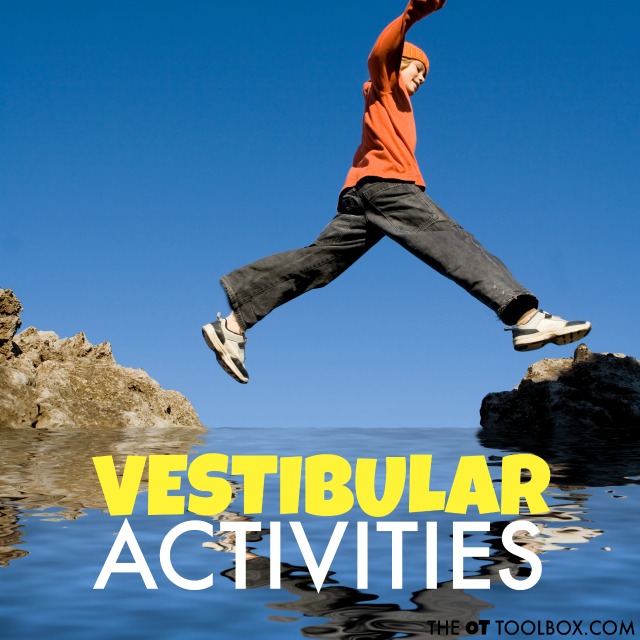

Vestibular Input and the Ear
You probably are aware of the connection between the ear and balance. But have you considered the connection between vestibular input and the ear, as well as hearing issues or auditory processing challenges?
The inner ear houses the vestibular apparatus, or the mechanics of the vestibular system. This includes the semicircular canals and otolith organs, as well as the cochlea. These organs are innervated by the 8th cranial nerve. The semicircular canals are three circular shapes which are positioned in three different planes. The plane positioning provides information about movement in a three dimensional space, which is how we move through the world around us.
The microscopic hair cells respond to the movements we make, with input on acceleration and deceleration of movement. All of these inputs are integrated to provide information to the body about rotary movements of the head and body, as well as our equilibrium.
Additional sensory receptors in the ear detect head movement in a three dimensional space and gravity and linear acceleration activate these movements.
Individuals with hearing loss or impairment as a result of the inner ear due to problems with the cochlea or auditory nerve may have vestibular problems.
Vestibular Sensory Processing Activities
Many of the movement activities that we covered above are great for targeting many skills, making them great tools in therapy. Simply playing and incorporating movement addresses skills like coordination, motor planning, strength, body awareness, position in space, core strength, bilateral coordination, and many other areas that impact function.
Simple vestibular exercises like the ones listed below can be added to therapy interventions like Simon Says Commands or obstacle courses to cover many areas of development:
- windmills
- jumping jacks
- standing cross crawls
- supine cross crunches
- toe touches
- Jungle Animal Heavy Work Coordination Exercises
- Animal walks
- hokey pokey
- Playing on a playground equipment
- balloon games
- crawling
- rolling
- supine to sitting motions
- sitting to side lying motions
- head and neck movements
- tilting the body from side to side
- lateral movements
- anteritor-postierior movements
- slow spinning
- rocking
- rolling over a therapy ball either lying down or while seated
- inversion of the head
Basically, adding in variations of basic movements as gentle vestibular input through body position changes supports the sensory input needed for calming or alerting.
All of these movements and movement combinations are an integration of the sensory systems (visual, tactile, proprioceptive, with vestibular). It’s pretty cool how they all work together in an integrated manner with movement and activity!
Precautions for vestibular Sensory Processing Movements
There are precautions for adding vestibular input, and this is something I definitely want to cover.
Some types of vestibular input can be especially contraindicated. Specifically, inversion of the head and fast spinning should be closely monitored with some diagnoses. These include:
- those with a trachostomy
- Those with seizures
- High blood pressure
When using vestibular input, especially the spinning and inversion types, be sure to monitor for results and keep an eye on heart rate, blood pressure, and eye movements.

